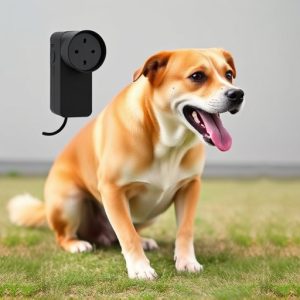Sonic Deterrent Range for Dogs: Training Tips and Behavior Modification
Dogs often exhibit behaviors that require management, such as barking or jumping, which can be addre…….
Dogs often exhibit behaviors that require management, such as barking or jumping, which can be addressed with ultrasonic frequency devices. These safe, inaudible-to-humans tools emit high-frequency sounds to deter dogs without causing harm. By strategically placing these devices, owners can teach their dogs to avoid certain areas and modify unwanted behaviors over time. Effective for breeds and situations varying in sensitivity, consistency is key when using sonic deterrent ranges, which should be a secondary or combined approach with other training methods.
“Unleash a new way to train your furry friend with ultrasonic frequency dog behavior modification tools—a revolutionary approach to canine discipline. This article explores how these innovative devices harness sound waves, known as sonic deterrents, to address unwanted behaviors. We’ll delve into the science behind it, from understanding canine perception to the precise range of ultrasonic frequencies that work effectively on dogs. Get ready to discover a safe and modern method for modifying your dog’s behavior.”
- Understanding Dog Behavior and Ultrasonic Deterrents
- How Sonic Deterrent Range for Dogs Works
- Benefits of Using an Ultrasonic Frequency Tool
- Training Tips and Considerations for Effective Use
Understanding Dog Behavior and Ultrasonic Deterrents
Dogs, like humans, have unique behaviors that can sometimes be challenging to manage. Understanding canine behavior is key when introducing any modification tool, including ultrasonic frequency devices designed for dogs. These tools emit high-frequency sounds that are inaudible to humans but can deter dogs from unwanted actions. The range of these sonic deterrents varies, and they are often used as a safe alternative to shock collars.
By understanding that dogs respond to their environment and certain stimuli, we can effectively use ultrasonic frequency tools. These devices target specific behaviors like barking excessively or jumping on furniture by emitting sounds that disrupt the dog’s attention, encouraging more desirable alternatives. The sonic deterrent range typically allows for localized treatment without affecting nearby humans or pets, making it a targeted and humane solution for modifying dog behavior.
How Sonic Deterrent Range for Dogs Works
The Sonic Deterrent Range for Dogs operates on a simple yet effective principle. It utilizes ultrasonic sound waves, which are high-frequency noises inaudible to humans but perceived as annoying or distressing by dogs. When activated, these sound waves emit from strategically placed devices, covering a specific area or range. The frequency and intensity of the ultrasound are carefully calibrated to be disruptive without causing harm to the dog’s hearing.
Dogs have highly sensitive auditory systems, and certain frequencies can trigger an instinctive reaction, such as freezing or leaving the area. This behavior modification tool takes advantage of this natural response, training dogs to associate specific sounds with discomfort or unease. Over time, the consistent use of ultrasonic deterrents helps alter their behavior, teaching them to stay away from areas where these sounds are produced.
Benefits of Using an Ultrasonic Frequency Tool
Using an ultrasonic frequency dog behavior modification tool offers a safe and effective way to address unwanted behaviors. Unlike traditional punishment methods, this technology employs a sonic deterrent range for dogs that is harmless and hard to detect by our canine companions. The high-frequency sound is specifically designed to capture a dog’s attention and disrupt their actions, training them towards more desirable behaviors.
These tools are particularly beneficial for modifying behaviors like barking, jumping, or aggression. They can be used in various settings, from homes to parks, providing pet owners with a versatile solution. Additionally, ultrasonic frequency devices promote positive reinforcement by enabling trainers to reward desired behavior simultaneously, fostering a stronger bond between the dog and its handler.
Training Tips and Considerations for Effective Use
When using an ultrasonic frequency dog behavior modification tool, it’s crucial to understand that consistency is key. Establish a routine and set clear expectations for your pet. Begin training in short, focused sessions, ideally under low-stress conditions, to prevent overwhelming the dog. Reward positive behaviors with treats and praise, reinforcing the desired actions consistently. Remember, these tools are most effective when used as a last resort or in conjunction with other behavior modification techniques.
The sonic deterrent range for dogs should be carefully considered. These devices emit high-frequency sound waves that are typically inaudible to humans but can deter dogs effectively. However, not all dogs react the same way, and some may find them less effective due to breed differences or individual sensitivity. Regularly check your dog’s reaction and adjust settings as needed. It’s important to note that these tools should never be used excessively or in environments where the sound might reach unsafe levels for humans or cause harm to the dog’s hearing.
An ultrasonic frequency dog behavior modification tool offers a non-invasive, humane solution for addressing unwanted behaviors. By leveraging the sonic deterrent range for dogs, these tools can help train pets to respond positively to specific commands and environments. With consistent use and proper training techniques, the benefits of an ultrasonic frequency tool can lead to improved canine behavior and a stronger bond between pet and owner. Remember that, in terms of effective training, patience and persistence are key when navigating this innovative approach.


